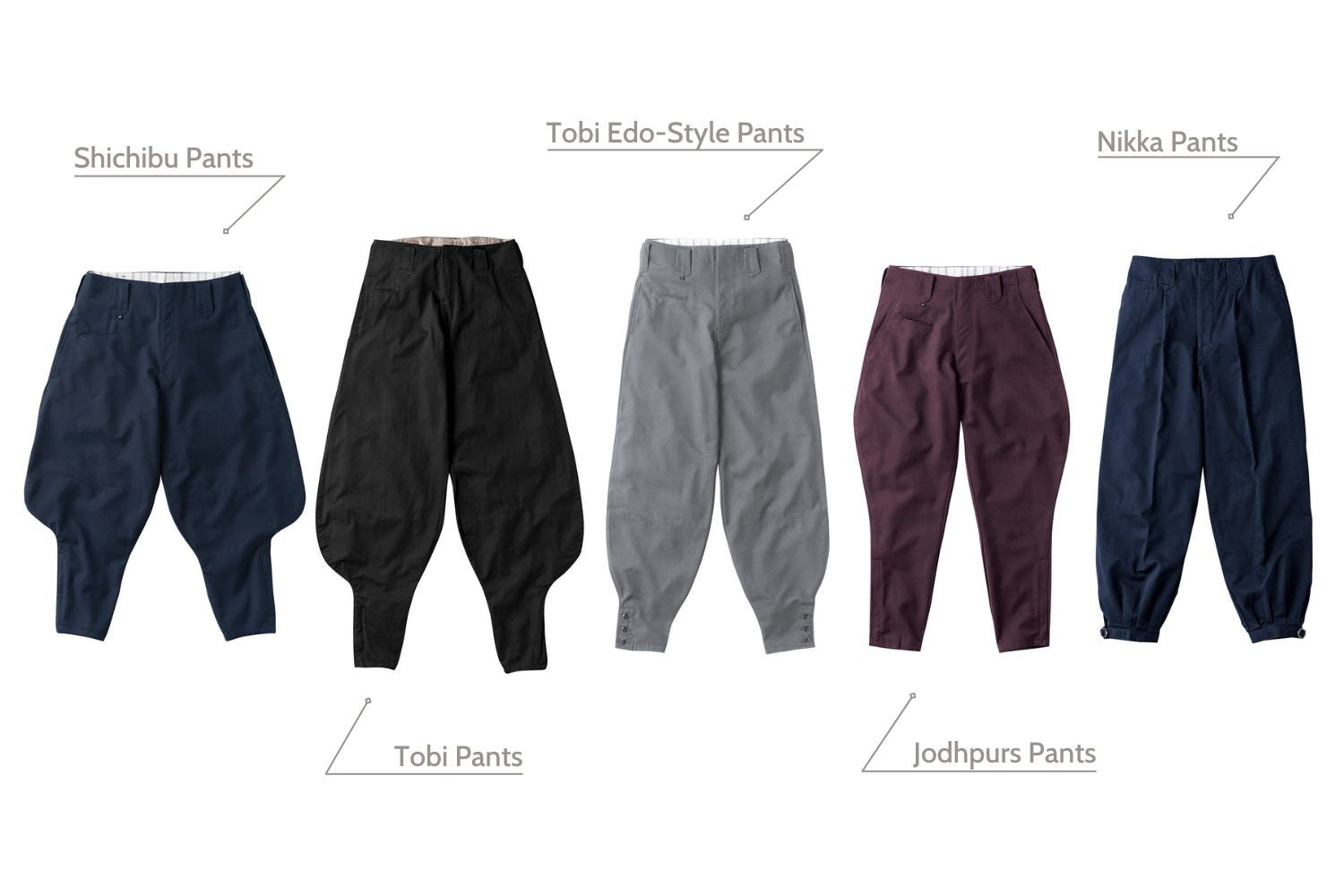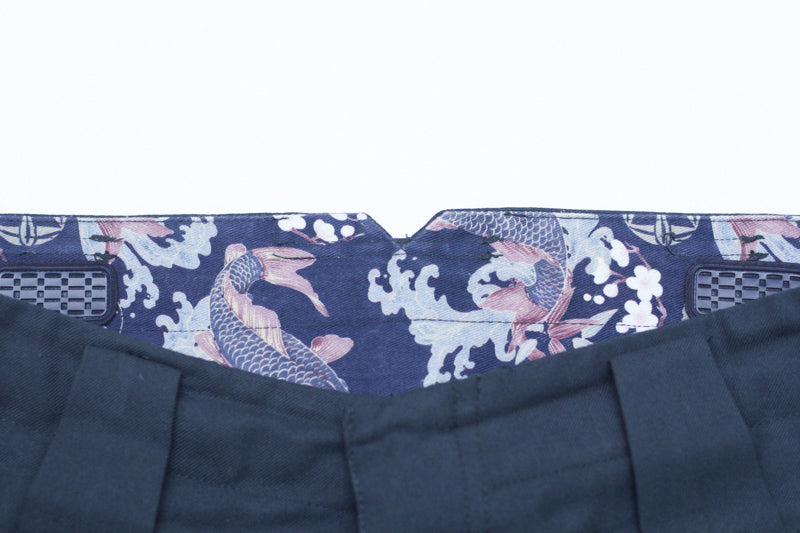
The 5 Different Cuts of Pants

When you are at the Nikka Zubon shop, you may be confused by the name of the pants. Indeed, we have different cuts of pants and each cut has a specific name.
In Japan, our pants are generally called nikka pokka, they are worn in the working world. The concept of nikka pokka has been reinvented year after year, resulting in a wide range of designs. Indeed, the nikka pokka have a mission to answer various professional uses. Each cup has its own characteristic.
In order to better understand these notions, here is a guide in which we would like to present you these different cuts of pants. This article is composed in 3 parts, a brief presentation of each cut, their characteristics and a look recommendation.
We hope you can find your ideal pants.
The 5 cuts of pants:
- Shichibu
- Tobi
- Edo-Style Tobi
- Jodhpurs
- Nikka
Before we get into the explanation, we'd like to draw your attention to one specific point. These 5 cuts of pants have one thing in common: they are all wide from the waist to the knees. The word nikka pokka comes from knickerbockers, knickers means knee in English.
Now let's see the characteristics of each of them.
1. Shichibu
History
The cut called Shichibu means 7/10th, that is to say the ratio between the flared and straight part of the pants. It is the first workwear model resulting from the mix between Dutch knickerbockers and Japanese hakama.
Characteristics
The Shichibu cut has the shortest length. As indicated in the name, the flared part stops at the 7/10th of the pants. This has the advantage of leaving a thinner leg line at the level of the shins.

Style tips
Thanks to its narrowing at a level close to the knee, it has the most original shape. It will go better on small people of size.
We recommend that you combine these pants with low shoes or ankle boots.

2. Tobi
History
A longer variation of Shichibu was born a few years later, the young craftsmen wished to have more stylish and fashionable pants, that's how the so-called Hachibu cut was born, meaning 8/10th. Hachibu have several lengths, Hachibu cho-long (8/10th very long), Hachibu chocho-long (8/10th very very long) etc. For simplicity, we call this cut just by "Tobi". These pants are the most common, it was often taken up by the manga culture in the 80s and 90s.
Characteristics
The Tobi cut is longer, the flared part stops at mid-shin height as indicated in its name Hachibu 8/10th of the length of the pants. It is used in particular to have a more powerful silhouette.
It can be easily worn and ready to use in no time, thanks to a zipper at the ankle.

Style tips
Once this pants is fixed, the flared part will come to cover the bottom of your shins so you can give volume on the high part of the calves. It is a model that will give you an extra powerful posture. Aim for a contrast with the top and you will have an active and determined silhouette. We recommend this model for tall people.

3. Edo-Style Tobi
History
The Edo-Style Tobi cup is a slimmer version of Tobi. In Japan, it is common that each region has its own version of a product. We find this phenomenon in various fields such as culinary specialties between the Kansai region (Osaka, Kyoto, Kobe) and the Kanto region (Tokyo formerly called Edo). In the same way, this version of Tobi was created.
Characteristics
The Edo-Style Tobi cut is less wide, or more slim than the Tobi cut. It is fixed at the ankles, with buttons unlike other models that were zippered. The buttons have the advantage of bringing relief and give an additional charm.

Style tips
This model has a long and straight cut line, it allows to keep an effect of extension of the leg. These pants will be ideal to lengthen your figure by accentuating the length of your legs. We recommend you wear it with a belt that will create a nice line between the upper and lower body.

4. Jodhpurs
History
The Jodhpurs cut is a riding pant (乗馬 joba pants in Japanese). Its origins date back to the 19th century, and are said to have originated in the military pants of northern India. In the jargon of Tobi shokunin we identify the pants in 3 major groups: Nikka pokka, Shichibu and Joba. These pants are mainly worn by Japanese landscapers an
Characteritics
The Jodhpurs cut is a version that we could almost define as more skinny. This cut is wide to the knees and then comes to hug the leg. Its zipper to fix the pants to your legs will keep a plain and elegant appearance.

Style tips
The advantage of these pants is that they allow you to refine your calves and leave room for the possibility of fitting shoes as well as boots. We recommend wearing them in a stylish and uncluttered way with just a shirt or a polo.

5. Nikka
History
The Nikka cut comes from knickerbockers worn by the Dutch in New York. These pants were developed and worn in many ways, for example for golf, mountaineering etc. In Japan, Nikka was taken over for work wear. Nowadays, Nikka is more versatile than other cuts, they are found in different fields such as matsuri (traditional dancing festivities), painters etc.
Characteristics
The Nikka cut has a simpler design. Indeed, it is straight and wide to the ankle with a closure that can be tightened slightly at the ankle.

Style tips
We recommend pairing these pants with casual shoes, shirts and T-shirts. As for outfits, you can choose from a straight top to stay in the same tone or break up the upper body with something more fitted.

Conclusion
In summary, these different cuts will bring you different silhouettes, taking into account your different morphologies, your sets and your imagination you will manage to create unique sets.
We hope to have given you more elements to let you try our pants.



Leave a comment
This site is protected by hCaptcha and the hCaptcha Privacy Policy and Terms of Service apply.